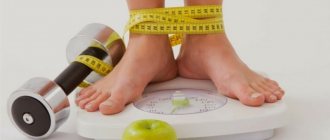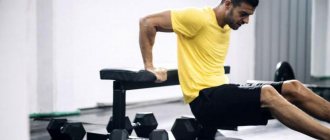Pregnancy is a wonderful stage in a woman’s life. However, it is often associated with accompanying changes in the body - transformation of the figure, hormonal changes, and so on. After the birth of a child, you want to quickly get into shape, put on your favorite “pre-pregnancy” jeans and enjoy the reflection in the mirror and the new status of motherhood.
Today, together with specialists from Elena Morozova’s weight loss clinic, we will cover the most common topics among young mothers - how long before you can exercise after giving birth, what contraindications there may be, and where to start training.
What effect does pregnancy have on the female body?
A woman’s body changes while expecting a child, this is primarily due to the fact that all internal resources are activated in the direction of protecting and developing the fetus. Hormonal levels change, metabolic processes slow down, which can result in weight gain. In addition, the pressure placed on the kidneys causes constant swelling, causing additional discomfort.
Our additional services: Bioimpedance | Marutaka Massage | Pressotherapy | Ion-Detox
Over time, along with the baby, the blood volume grows, the mammary glands fill, the amniotic membranes increase, so weight can rapidly increase. During childbirth, a woman loses most of the kilograms she had gained, the functioning of internal organs is restored, and swelling goes away.
However, if you do not adhere to a diet during pregnancy and “eat for two,” the problem of excess weight can be aggravated by fat deposits (usually around the waist and hips).
Comment from clinic nutritionist Elena Morozova:
To avoid the difficulties of postpartum recovery, it is recommended to monitor your diet - it should be balanced and beneficial for the health of the mother (especially the nursing mother). Healthy eating habits will help you quickly get into shape and get back into your daily routine. For an individual diet program, you should contact the professionals at our clinic. They will help you choose the necessary nutritional complex that will help maintain harmony between weight and optimal body condition in the initial period of caring for your child.
Where to start
An important rule is gradualness, regardless of the exercises performed. A woman who has recently become a mother is contraindicated from lifting weights, so it is advisable to exclude barbells and heavy dumbbells (even if she preferred this type of load) for the first time. After six months, you can begin the first significant strength loads.
When wondering when to go to the gym after giving birth, a woman should start with activity at home and only then switch to a sports regime. Walking with your baby, walking, active household chores - this will help you get back in shape faster and prepare mentally and physically for exercise in the gym.
Active fitness is not recommended for a woman during lactation. During power loads, lactic acid is released, which enters the milk and spoils its taste. The baby will simply refuse to eat such a healthy product. During this period, you can do Pilates, use balls and benches to pump up your abs and strengthen your abdominal muscles. At the end of lactation, you can give preference to water aerobics, running or dancing.
Why you can’t start playing sports immediately after giving birth
During labor, a woman experiences severe overload, which affects her general condition. Practice shows that a weakened body is restored only by 6-8 weeks after the birth of a child. Internal organs and systems gradually return to normal activity. The uterus contracts to its normal state, the wound heals at the junction with the placenta.
The main reason why doctors prohibit sports training in the first weeks after maternity hospital is the risk of bleeding and associated complications and the development of internal pathologies. It is also not recommended to visit the bathhouse, swimming pool or lift heavy objects. During this period, the young mother should avoid physically active activities and pay more attention to the baby.
In addition, there are special contraindications for women in labor who have undergone a cesarean section. Changes to the regimen should be made with great caution and only in consultation with your doctor.
When is it safe to have sex after giving birth?
In most cases, a mother can return to sexual activity after the birth of a child 6-8 weeks after the birth of the baby. During this time, all wound surfaces and sutures heal (if there were ruptures or incisions were made), reverse development (reduction in size) of all organs that changed during pregnancy occurs (with the exception of the mammary glands, which increase after childbirth), and the gaping of the cervix decreases . During the first 4-6 weeks after birth, the mother experiences vaginal bleeding - lochia, the color of which gradually changes from red to brownish. Abstinence from vaginal and anal sex during this period allows all wounds to heal without complications and avoid wound infection. Also during this period, the normal tone of the muscles of the vagina and perineum is usually restored. By 12 weeks after birth, ¾ of all couples return to vaginal sex. 1 year after the birth of a child, sexual relations resume in almost 100% of couples.
How soon after giving birth can you exercise?
No one can tell you in advance the exact dates when you can start or resume training - each case is individual, and you can judge the readiness of your body only by its condition and well-being.
Psychological factors are often included. Postpartum depression and accumulated fatigue due to the arrival of a new family member requiring constant attention leave no energy for physical exercise.
If you have no special contraindications and you feel the desire and a surge of strength, you can join a stable training regime after 2 months under the supervision of specialists. It should be remembered that you need to start with small volumes and choose sports complexes and types of fitness, taking into account the specifics of postpartum recovery and breastfeeding.
Exercise after natural childbirth
Some experts on the question of when you can play sports after natural childbirth adhere to the position “the sooner, the more effective.” If everything went smoothly during labor, without injuries or ruptures, there are no direct contraindications to moderate exercise.
Rehabilitation exercises for some muscle groups can begin on the second day after discharge. Such gymnastics may include training to tone the chest, abdomen and back area from a lying position.
During the postpartum period, it is necessary to monitor the nature of the discharge - if its volume steadily decreases, already in the second week, with the permission of the doctor, you can smoothly move on to your favorite types of training.
Natural birth with complications
If a woman in labor experiences internal or external ruptures, or requires surgical intervention during the process, any stress is prohibited for 1 month. The attending physician monitors the healing process and only he can give an opinion on how soon you can play sports after such a birth.
Features of classes after childbirth
So, let's look at the features of classes after childbirth.
Our body is prepared and ready for moderate stress. If a woman is a beginner, then it is worth contacting an experienced instructor who will create a competent program. An advanced user can independently control their loads. This approach must involve the stomach, back, legs, hips and, to a lesser extent, arms.
You need to start your workout with a warm-up , which includes cardio equipment. After giving birth, running should be avoided. This type of activity can harm the breasts and cause a disruption in milk production. It is imperative to wear a sports top that will support your mammary glands. An excellent simulator for postpartum adaptation is the ellipse. You need to start with 10 minutes and with each workout increase the sessions by 5 minutes until you reach 40. Always pay attention to your condition and be guided by how you feel. Listen to your body.
You can get your body in shape effectively and as correctly as possible by using all muscle groups in your workouts. After 1.5 - 2 months, divide your workouts into days, each of which will pay attention only to a specific muscle group . The increase in load must be gradual. Take special time to warm up.
The nuances of physical activity during caesarean section
Removing a baby from the mother's womb through surgery is characterized by a long healing period. The sutures at the site of the incision of the abdominal wall and uterus are sensitive to any physical stress for two months and require special treatment during the recovery process.
If a woman was actively exercising before pregnancy, she will be able to resume full training no earlier than six months later, gradually increasing the load. To avoid ruptures and bleeding, a woman in labor should be regularly monitored by a doctor.
Comment from clinic specialist Elena Morozova:
An individual approach to each patient allows us to select the optimal set of procedures and form useful habits for a safe and effective result.
Find out more about our weight loss programs:
If a young mother has stopped controlling her food intake and following a routine, she will have to deal with the issue of being slim longer and more diligently. Breastfeeding mothers are shown aerobic directions and a diet within the approved nutrition system. The regimen should include 5-6 meals a day in small portions.
When changing habits, you should monitor the quality and quantity of milk - excessive loads and drastic changes in diet can affect its taste and lead to problems with lactation.
Abdominal muscle recovery: when can you start exercising after childbirth?
The condition of the abdominal press depends on the degree of muscle stretching, so the recovery period is difficult to predict. In some cases, a flat stomach is observed within a week after the birth of children. The standard time to gain muscle tone and return the uterus to normal is two to six weeks.
Untrained girls with unathletic physique have a longer road to slimness. Stretch marks, sagging skin, sagging belly and other unpleasant problems are often observed.
Abdominal exercises should be started only after postpartum injuries have completely healed, so as not to provoke uterine bleeding and prolapse of internal organs.
Working with posture
In a pregnant woman, the bones of the pelvis and chest are deformed, and the center of gravity shifts as the fetus grows. All these factors have a direct impact on gait and posture. The mother is forced to constantly carry the child in her arms, the pressure on the neck and back only increases, leading to painful sensations in the lumbar region and the cervical-collar area.
The best time to start playing sports after pregnancy and childbirth to strengthen your posture is the second week. To start, consider exercises from a lying position. Massage is also an effective remedy.
How is the second scheduled visit to the obstetrician-gynecologist going?
The young mother's first visit to the doctor is planned for 2-3 weeks after the baby is born, and the second scheduled examination is recommended to be carried out no later than 8 weeks. If it is not practical to prescribe a detailed diagnosis immediately after discharge from the maternity hospital, then during the second appointment the specialist may recommend an ultrasound of the pelvic organs and mammary glands, a smear for oncocytology, or colposcopy. Of course, the doctor prescribes all this after a gynecological examination.
Intimate life after childbirth is restored just from the 8th week, so the obstetrician-gynecologist discusses with the patient issues of contraception and planning for a possible next pregnancy. It may seem that it is too early to talk about other children. The probability of pregnancy occurring in the first ovulatory cycle is very high. That is, you can get pregnant even before your first menstruation occurs after childbirth. Moreover, this is possible even if there were difficulties with the onset of this pregnancy. A woman’s body may not yet be physically ready to bear a subsequent pregnancy, or the couple may not yet be ready psychologically.
However, if parents are planning a second baby, they should understand that too long or short an interval between births may be associated with additional risks.
Difficulties may also arise with intimate life that the patient has not encountered before: for example, dry mucous membranes. The obstetrician-gynecologist should discuss this issue with the patient and give recommendations on the use of means that eliminate problems of intimate life after childbirth.
In the following months, changes will occur in the woman’s body: stretch marks will fade, hair may begin to fall out, and temporary urinary incontinence will appear. The doctor’s task is to warn the patient so that natural processes do not cause her to panic or lead to stress. Many mothers expect quick recovery and weight loss, but this is the exception rather than the rule, and a specialist should prepare the woman for this. The obstetrician-gynecologist will give recommendations for a speedy recovery.
A separate big issue is physical exercise. Mothers sometimes strive to regain prenatal weight as quickly as possible or restore the exercise schedule they previously followed. The doctor should give recommendations in this regard, based on the patient’s condition and the characteristics of her body. But in any case, the obstetrician-gynecologist must convey the idea that until the body recovers completely, physical activity should be gentle and strictly dosed.
How to start training in the first weeks
You can plan exercises in a lighter mode already in the maternity hospital, if there are no contraindications. Here are some useful recommendations for comfortable organization of the training process:
- choose the right comfortable clothes, made of breathable materials that do not restrict movement;
- ventilate the room;
- start exercising after feeding the baby;
- do not make sudden movements, especially at the beginning of the recovery journey - listen to your body and well-being.
We have already found out that you can play sports almost immediately after giving birth. Our gentle complex is suitable for women in labor at the stage of discharge from the hospital. It can be performed on a sofa or fitness mat, lying down:
- breathing exercises for warming up - while inhaling, the abdominal muscles are relaxed, exhaling - we pull in the stomach as much as possible;
- starting position: legs bent at the knees, back straight. As you exhale, the pelvis rises, while inhaling, you return to the starting position;
- lying on your stomach, lift your legs (bending at the knees) alternating, 10-12 repetitions for each;
- “pedaling” is performed from a supine position. You can start with 30 seconds, gradually increasing intensity and time;
- turns the body to the left and right from a position lying on your back, without lifting your feet from the surface of the bed, while your legs are bent at the knees.
Comment from clinic specialist Elena Morozova:
To achieve the fastest effect, exercise sets should be correctly combined with a diet. Breastfeeding and postpartum recovery impose serious restrictions on a woman’s diet. Qualified nutritionists at our clinic develop individual programs taking into account the characteristics of the patient’s body and lifestyle, aimed at achieving a slim figure, and also give practical recommendations on how to diversify the menu during this period.
Exercises in the gym
Vertical pull-down (back)
First you need to take the most comfortable weight. In the future we will increase it. Sit on a bench. Hand placement - wide grip. Bend your torso slightly back. As you pull the block, squeeze your shoulder blades together.
15 reps, 4 sets.
Seated dumbbell press (shoulders + back)
Sit on a bench, keep your back straight. Starting position: spread your arms to the sides, bend your elbows at an angle of 90 degrees. The hands are directed upward “away from you”, we hold the dumbbells at temple level, we straighten our arms upward, above our heads. Hands do not touch each other.
10-12 repetitions, 4 sets.
Scott Bench Curl (biceps curls)
Find a comfortable position on the machine. Both a barbell and a pair of dumbbells work well for this exercise. Elbows are approximately shoulder width apart. Bend your arms, slowly lifting the weight to your chin. Remember that you need to start with light weights. Do not use the force of inertia, control the process.
Arm extension in the upper block (triceps arms)
For this exercise, use a cable handle in a crossover. Grab the ends of the handle and take a small step back, fix a slight bend in the lower back, tilt your torso slightly. When performing the exercise, try to extend your arms completely.
10-12 repetitions, 4 sets.
Incline dumbbell press (chest)
Set the incline bench to 30 degrees. Sit comfortably on it. Take dumbbells with a light weight (we will increase it during training). Straighten your elbows above your body. Lower to ear level.
Make sure your hands move along the same line.
10-12 repetitions, 4 sets.
“Leg press” (biceps and triceps thighs + buttocks)
The working weight in this case is the weight of the platform. Feet at shoulder width. Push the platform with weight through your heels. Do not fully extend your legs at the top. It is worth lowering the platform until the body begins to rise.
Perform 15 repetitions of 4 sets.
Squats (legs)
Squats are best done with a barbell without weight. Over time, when the body gets used to the load, you can add 5 kg, then 10 kg and so on.
Crunches (press)
This exercise is performed lying face up on the floor. Hands with palms on the back of the head, legs bent at the knees, feet pressed firmly to the floor. Tighten your abdominal muscles and pull your shoulders toward your pelvis. Do not lift your lower back off the floor.
Be sure to take breaks and rest. Monitor your condition. If you feel pain in the abdomen, dizziness or nausea, you should stop training or switch to lighter exercises, while taking a few minutes of rest. Exercise regularly, then the effect will not be long in coming. Listen to yourself, this will help you make certain adjustments to your workouts that are right for you.
Add exercises such as breathing exercises and stretching to your gym sessions. Be healthy!
Which sport is better to choose?
Decide on the type of physical activity that is suitable specifically for you. Several factors are taken into account here:
- general well-being;
- age;
- individual physical capabilities and characteristics;
- personal preferences.
Dancing is one of the effective exercises that helps tone muscles. In addition, group classes and musical accompaniment have a positive psychological effect, charging with energy and mood.
Water training - swimming and water aerobics - are indicated both during pregnancy and as rehabilitation complexes. The exercises involve all muscle groups, and the aquatic environment is rightfully considered the least traumatic and has a relaxing effect. It should be remembered that in the early stages of recovery, when the uterus has not yet healed and characteristic postpartum discharge is present, you should wait a while with the pool.
Yoga is one of the most popular trends today. You can conduct sessions at home yourself if you are unable to leave your child. Choose an individual set of asanas for yourself and train at a convenient time, starting with short intervals, gradually increasing them.
If you have already chosen a sport or would like to return to previous hobbies, consult with your doctor when you can start training after childbirth and get into your usual routine, gradually increasing the volume.
What activities are prohibited
Experts in the field of obstetrics and gynecology advise not to rush into active exercise before the body has become stronger after the stress of childbirth. Official medicine is opposed to weightlifting, intense running and cycling in the early stages of the recovery process.
Look at our Clients' Acknowledgments and Success Stories - View
Women for whom sport is a profession can shorten the recovery period, but do this under the strict guidance of a coach and the supervision of doctors. If you lead a measured lifestyle, you should not follow a fitness guru - the criteria and time frame for getting into shape are individual for everyone and depend, among other things, on genetic predisposition and the fitness of the body.
Remember that the main task of a caring mother is to raise a healthy child. Do not neglect the recommendations of specialists and listen to the capabilities of your body.










